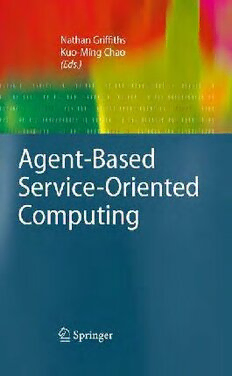Table Of ContentAdvanced Information and Knowledge Processing
SeriesEditors
ProfessorLakhmiJain
[email protected]
ProfessorXindongWu
[email protected]
Forfurthervolumes:
http://www.springer.com/series/4738
·
Nathan Griffiths Kuo-Ming Chao
Editors
Agent-Based
Service-Oriented Computing
123
Editors
Dr.NathanGriffiths Prof.Kuo-MingChao
UniversityofWarwick CoventryUniversity
Coventry Coventry
UK UK
ISBN978-1-84996-040-3 e-ISBN978-1-84996-041-0
DOI10.1007/978-1-84996-041-0
SpringerLondonDordrechtHeidelbergNewYork
BritishLibraryCataloguinginPublicationData
AcataloguerecordforthisbookisavailablefromtheBritishLibrary
LibraryofCongressControlNumber:2009943261
(cid:2)c Springer-VerlagLondonLimited2010
Apart from any fair dealing for the purposes of research or private study, or criticism or review, as
permittedundertheCopyright,DesignsandPatentsAct1988,thispublicationmayonlybereproduced,
stored or transmitted, in any form or by any means, with the prior permission in writing of the
publishers,orinthecaseofreprographicreproductioninaccordancewiththetermsoflicensesissued
bytheCopyrightLicensingAgency.Enquiriesconcerningreproductionoutsidethosetermsshouldbe
senttothepublishers.
Theuseofregisterednames,trademarks,etc.,inthispublicationdoesnotimply,evenintheabsenceofa
specificstatement,thatsuchnamesareexemptfromtherelevantlawsandregulationsandthereforefree
forgeneraluse.
Thepublishermakesnorepresentation,expressorimplied,withregardtotheaccuracyoftheinformation
containedinthisbookandcannotacceptanylegalresponsibilityorliabilityforanyerrorsoromissions
thatmaybemade.
Printedonacid-freepaper
SpringerispartofSpringerScience+BusinessMedia(www.springer.com)
Preface
Service-orientedcomputing(SOC)hasrapidlybecomeanestablishedapproachfor
supporting the construction and management of distributed applications. A range
oftools,techniquesandstandardshaveemergedtosupporttheconstruction,publi-
cation, discovery, composition and management of services. Agent-based systems
are a natural complement to SOC and can provide the intelligence and reasoning
capabilitiesthatareneededtoeffectivelysupportandmanagetheresultingsystems.
The integration of agents and SOC is an active research area, and the goal of
thisbookistogiveanoverviewofcurrentresearchandtechniques,andtoidentify
themostlikelyfuturedirections.Thisbookisacollectionofchaptersthatdiscuss
themaincurrentareasofresearch,alongwithachapterdevotedtoselectedfuture
directions that we see as important. We also include a chapter that introduces the
basicnotionsofSOC,tokeepthebookaccessibletoageneralreader.
Wewouldliketoexpressourgratitudetotheauthorswhohavecontributedtheir
research,andtoRebeccaMowat,BeverleyFordandeveryoneatSpringerwhohas
helpedwiththepublicationofthisbook.
Coventry,UK NathanGriffiths
September2009 Kuo-MingChao
v
Contents
1 Introduction................................................ 1
Kuo-MingChaoandNathanGriffiths
1.1 DistributedSystems ....................................... 1
1.2 SoftwareAgents .......................................... 2
1.3 Service-OrientedArchitectures.............................. 4
1.4 ModellingMethodologies .................................. 5
1.4.1 AgentModellingMethodologies..................... 6
1.4.2 SOAModellingMethodologies...................... 7
1.4.3 AgentsandServices ............................... 8
1.5 SupportingDevelopmentPlatforms .......................... 9
1.6 AgentsandSOAStandards ................................. 10
1.6.1 FoundationforIntelligentPhysicalAgents(FIPA) ...... 11
1.6.2 SOAandWebServiceArchitectureStandards.......... 11
1.7 OverviewofChapters...................................... 13
1.8 Conclusion............................................... 17
References..................................................... 17
2 ServiceAdvertisementandDiscovery........................... 21
ShanshanYangandMikeJoy
2.1 IntroductiontoServiceAdvertisementandDiscovery ........... 21
2.2 BasicTechnologies........................................ 24
2.2.1 SOAP ........................................... 24
2.2.2 WSDL........................................... 25
2.2.3 UDDI ........................................... 25
2.3 WebServiceRegistryArchitectures .......................... 26
2.3.1 CentralisedRegistries.............................. 26
2.3.2 DecentralisedRegistries............................ 27
2.3.3 HybridRegistries.................................. 30
2.4 DataStructures ........................................... 31
2.5 SystemRequirements...................................... 33
2.6 AdvertisementandDiscoveryServices ....................... 34
vii
viii Contents
2.7 AgentsinServiceAdvertisementandDiscovery ............... 36
2.7.1 AgentsinServiceOrientedComputing ............... 36
2.7.2 Development of Agents in Service Advertisement
andDiscovery .................................... 37
2.8 ChallengesinServiceAdvertisementandDiscovery ............ 40
2.8.1 SystemRequirements .............................. 41
2.8.2 SystemModelling ................................. 41
2.9 Summary ................................................ 41
References..................................................... 42
3 Multi-AgentCoordinationforServiceComposition............... 47
JunzhouLuo,WeiLi,BoLiu,XiaoZhengandFangDong
3.1 Introduction.............................................. 48
3.2 Preliminaries ............................................. 49
3.2.1 ServiceComposition............................... 49
3.2.2 QoSAttributesandUserSatisfactionDegreeofService . 52
3.2.3 TaskGraph....................................... 53
3.2.4 ServiceCompositionGraph......................... 54
3.2.5 FromTaskGraphtoServicesCompositionGraph ...... 55
3.2.6 TheFundamentalsoftheAntAlgorithm .............. 56
3.3 RelatedWork............................................. 57
3.3.1 FrameworkofServiceComposition .................. 57
3.3.2 ServiceCompositionPlanGeneration ................ 58
3.3.3 ServiceSelectionandPlanOptimization .............. 58
3.3.4 Multi-AgentBasedServiceComposition.............. 59
3.4 ArchitectureofMQSC..................................... 60
3.4.1 PortalAgent...................................... 60
3.4.2 DecisionAgent ................................... 61
3.4.3 SearchAgent ..................................... 61
3.4.4 RegistryAgent.................................... 62
3.4.5 ManagementAgent................................ 62
3.4.6 ExecutionAgent .................................. 62
3.5 ServiceCompositionGeneration ............................ 63
3.5.1 ServiceSearchandCompositionPlanGeneration....... 63
3.5.2 QoS-AwareServiceSelection ....................... 64
3.6 ServiceCompositionDeploymentandExecution............... 66
3.6.1 HowtoManagetheEAtoImplementtheComposite
PlanfortheMA................................... 67
3.6.2 ThePlanSchedulingAlgorithmoftheEA............. 67
3.6.3 AnExamplefortheSchedulingAlgorithmoftheEA.... 69
3.7 CaseStudy............................................... 71
3.7.1 CaseScenarioDescription .......................... 71
3.7.2 Multi-AgentSystemforServiceComposition.......... 74
3.7.3 TravelAssistantServiceCompositing ................ 75
3.8 ConclusionandFutureWork................................ 78
References..................................................... 79
Contents ix
4 FlexibleWorkflowManagementinServiceOrientedEnvironments . 81
BirgitHofreiterandChristianHuemer
4.1 Introduction.............................................. 81
4.2 OrchestrationandChoreography ............................ 83
4.2.1 MotivationandDefinitions.......................... 83
4.2.2 Orchestration ..................................... 84
4.2.3 LocalChoreography ............................... 86
4.2.4 GlobalChoreography .............................. 88
4.2.5 Approaches to Transform Between Orchestration
andChoreography................................. 89
4.3 WorkflowandWebServices ................................ 90
4.3.1 WebServicesStandardsforBusinessProcesses ........ 90
4.3.2 SpecifyingaBusinessProcessbyMeansofBPEL ...... 90
4.3.3 AnalyzingBPELbyWorkflowPatterns ............... 97
4.4 TheRoleofAgentsinService-BasedBusinessProcesses........ 98
4.5 DynamicWorkflows.......................................100
4.5.1 DynamicSelectionofBestServiceProviders ..........100
4.5.2 ChangestotheWorkflowSchema....................103
4.6 SummaryandOutlook .....................................107
References.....................................................108
5 SemanticsforService-OrientedArchitectures.................... 113
MichaelStollbergandDieterFensel
5.1 Introduction..............................................113
5.2 WebServicesandSOA ....................................115
5.2.1 WebServices .....................................115
5.2.2 Service-OrientedArchitectures ......................117
5.3 SemanticWebServices ....................................119
5.3.1 OntologiesandtheSemanticWeb....................120
5.3.2 SWSFrameworks .................................122
5.4 SemanticTechniquesforAutomatingSOA....................126
5.4.1 Discovery........................................127
5.4.2 SelectionandRanking .............................129
5.4.3 BehavioralCompatibility ...........................130
5.4.4 Composition......................................130
5.4.5 Mediation........................................131
5.4.6 AutomatedExecution ..............................132
5.5 ConclusionsandOutlook...................................132
5.5.1 Summary ........................................133
5.5.2 FutureChallenges .................................134
References.....................................................135
x Contents
6 DependabilityinService-OrientedComputing ................... 141
ArshadJhumka
6.1 Introduction..............................................141
6.2 Service-OrientedArchitecture...............................143
6.2.1 DependabilityIssuesinService-OrientedArchitectures..146
6.3 Models..................................................147
6.3.1 SystemModels ...................................147
6.3.2 FaultModels .....................................148
6.4 DependabilityEnhancementinaServiceOrientedArchitecture...152
6.4.1 FaultPrevention...................................152
6.4.2 FaultTolerance ...................................153
6.4.3 FaultRemoval ....................................154
6.4.4 FaultForecasting:FaultInjection ....................154
6.5 DependabilityEvaluation...................................155
6.6 CaseStudies .............................................157
6.6.1 AWeb-BasedApplication ..........................157
6.6.2 Service-OrientedComputinginUbiquitousSystems ....159
6.7 Conclusions..............................................159
References.....................................................160
7 ConsensusIssuesforServiceAdvertisementandSelection ......... 161
PingWang,Chi-ChunLoandLeonSmalov
7.1 Introduction..............................................161
7.1.1 SemanticConfusion ...............................162
7.1.2 ReachingConsensus ...............................164
7.2 ExistingSolutionsforWebServiceSelection ..................165
7.3 TheProposedQoS-AwareServicesSelectionModel ............170
7.3.1 BasicDefinitionsandNotations .....................171
7.3.2 ConsistenceandInconsistenceMeasurements..........171
7.3.3 ProblemFormulation ..............................174
7.4 TwoNumericalCases......................................176
7.4.1 NumericalCaseI..................................176
7.4.2 NumericalCaseII .................................179
7.5 Discussion ...............................................184
7.6 Conclusion...............................................185
References.....................................................185
8 TrustandReputation ........................................ 189
SarahN.LimChoiKeungandNathanGriffiths
8.1 Introduction..............................................189
8.2 TrustandReputation ......................................190
8.2.1 Trust ............................................190
8.2.2 Reputation .......................................191
8.2.3 TheMultipleApproachestoTrustandReputationModels191
8.2.4 ReviewofTrustandReputationModels...............194
8.2.5 SummaryofViewsofTrustandReputationModels.....210
Contents xi
8.3 AgentsandService-OrientedComputing......................211
8.3.1 Peer-to-PeerArchitectures ..........................211
8.3.2 GridComputing...................................215
8.4 TrustClassesandOntologies................................218
8.4.1 TrustSemantics...................................219
8.5 Summary ................................................220
References.....................................................220
9 QoS-AwareServiceSelection ................................. 225
JamesW.J.XueandStephenA.Jarvis
9.1 Introduction..............................................225
9.2 ServiceSelectionProcedure ................................226
9.3 CaseStudy—SelectionofSwitchingService ..................227
9.3.1 ServerSwitchinginInternetHostingCentres ..........227
9.3.2 ServerSwitchingProcedure.........................229
9.3.3 ModellingMulti-tierInternetServices ................229
9.3.4 ModelParameterisation ............................232
9.3.5 BottleneckIdentificationofMulti-tierArchitecture .....232
9.3.6 ServerSwitchingforRevenueMaximisation...........234
9.3.7 SwitchingPolicies.................................236
9.3.8 ProactiveandReactiveSwitching ....................239
9.3.9 AdmissionControl ................................240
9.4 PerformanceEvaluation....................................240
9.4.1 ExperimentalSetup................................240
9.4.2 EvaluationResults.................................241
9.5 TheSelectionofSwitchingServices .........................249
9.6 Summary ................................................250
References.....................................................250
10 FutureDirections ........................................... 253
NathanGriffiths,Kuo-MingChao,SimonMiles,SanjayModgil,Nir
Oren,MichaelLuckandKwei-JayLin
10.1 Introduction..............................................254
10.2 TrustandReputation ......................................254
10.2.1 Standardisation ...................................255
10.2.2 TechnologyIntegration.............................256
10.2.3 FurtherChallengesforTrustandReputation ...........257
10.3 Contract-BasedSystems ...................................258
10.3.1 ElectronicContracts ...............................259
10.3.2 ConceptualFrameworksforContract-BasedSystems....260
10.3.3 SupportingArchitecturesforContract-BasedSystems...260
10.3.4 ExistingWorkandFutureDirections .................261
10.4 ServiceAccountability.....................................262
10.4.1 IntroductiontoAccountability.......................263
10.4.2 SOAAccountability ...............................263
10.4.3 AccountableServiceComputingModel...............264

